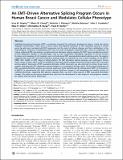An EMT-Driven Alternative Splicing Program Occurs in Human Breast Cancer and Modulates Cellular Phenotype
Author(s)
Shapiro, Irina M.; Flytzanis, Nicholas C.; Balsamo, Michele; Condeelis, John S.; Oktay, Maja H.; Gertler, Frank; Cheng, Albert Wu; Burge, Christopher B; ... Show more Show less
DownloadShapiro-2011-An EMT-Driven Altern.pdf (4.367Mb)
PUBLISHER_CC
Publisher with Creative Commons License
Creative Commons Attribution
Terms of use
Metadata
Show full item recordAbstract
Epithelial-mesenchymal transition (EMT), a mechanism important for embryonic development, plays a critical role during malignant transformation. While much is known about transcriptional regulation of EMT, alternative splicing of several genes has also been correlated with EMT progression, but the extent of splicing changes and their contributions to the morphological conversion accompanying EMT have not been investigated comprehensively. Using an established cell culture model and RNA–Seq analyses, we determined an alternative splicing signature for EMT. Genes encoding key drivers of EMT–dependent changes in cell phenotype, such as actin cytoskeleton remodeling, regulation of cell–cell junction formation, and regulation of cell migration, were enriched among EMT–associated alternatively splicing events. Our analysis suggested that most EMT–associated alternative splicing events are regulated by one or more members of the RBFOX, MBNL, CELF, hnRNP, or ESRP classes of splicing factors. The EMT alternative splicing signature was confirmed in human breast cancer cell lines, which could be classified into basal and luminal subtypes based exclusively on their EMT–associated splicing pattern. Expression of EMT–associated alternative mRNA transcripts was also observed in primary breast cancer samples, indicating that EMT–dependent splicing changes occur commonly in human tumors. The functional significance of EMT–associated alternative splicing was tested by expression of the epithelial-specific splicing factor ESRP1 or by depletion of RBFOX2 in mesenchymal cells, both of which elicited significant changes in cell morphology and motility towards an epithelial phenotype, suggesting that splicing regulation alone can drive critical aspects of EMT–associated phenotypic changes. The molecular description obtained here may aid in the development of new diagnostic and prognostic markers for analysis of breast cancer progression.
Date issued
2011-08Department
Massachusetts Institute of Technology. Computational and Systems Biology Program; Massachusetts Institute of Technology. Department of Biological Engineering; Massachusetts Institute of Technology. Department of Biology; Koch Institute for Integrative Cancer Research at MITJournal
PLoS Genetics
Publisher
Public Library of Science
Citation
Shapiro, Irina M. et al. “An EMT–Driven Alternative Splicing Program Occurs in Human Breast Cancer and Modulates Cellular Phenotype.” Ed. Nancy B. Spinner. PLoS Genetics 7 (2011): e1002218.
Version: Final published version
ISSN
1553-7404
1553-7390